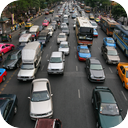(short preview of full seamless looping track)
(short preview of full seamless looping track)
(short preview of full seamless looping track)
(short preview of full seamless looping track)
(short preview of full seamless looping track)
Midday Traffic
This product is not available in the selected currency.
In Stock
Backordered
Out of Stock
Description
The street scene is once again alive for another day of daydreaming taxi drivers and groups of ballet dancers on their way to class. You sit in the cafe watching the normality of it all and become bored. You can't wait for the sun to go home and the moon to rise so that discontent drivers and drunken pedestrians can finally take back the streets from these overly obedient and obviously boring, city dwelling, urban impostors. Organized traffic generally has well-established priorities, lanes, right-of-way, and traffic control at intersections. Traffic is formally organized in many jurisdictions, with marked lanes, junctions, intersections, interchanges, traffic signals, or signs. Traffic is often classified by type: heavy motor vehicle (e.g., car, truck); other vehicle (e.g., moped, bicycle); and pedestrian. Different classes may share speed limits and easement, or may be segregated. Some jurisdictions may have very detailed and complex rules of the road while others rely more on drivers' common sense and willingness to cooperate.Organization typically produces a better combination of travel safety and efficiency. Events which disrupt the flow and may cause traffic to degenerate into a disorganized mess include: road construction, collisions and debris in the roadway. On particularly busy freeways, a minor disruption may persist in a phenomenon known as traffic waves. A complete breakdown of organization may result in traffic jams and gridlock. Simulations of organized traffic frequently involve queuing theory, stochastic processes and equations of mathematical physics applied to traffic flow.
Opps
Sorry, it looks like some products are not available in selected quantity.



